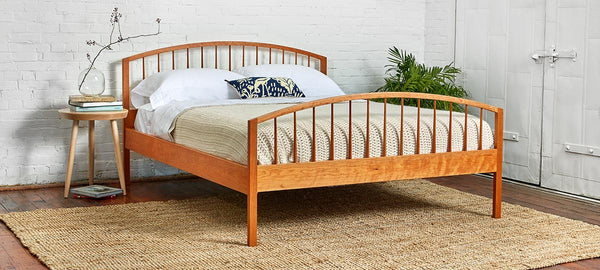Our Shaker Classic Bed, when ordered as a "conventional" bed, has slats across the side rails to support a box spring, which in turn supports your mattress.
We are frequently asked about the difference between a "conventional" (requiring a box spring) or a "platform" bed frame, and whether one is better than the other. Some beds are designed exclusively as a platform or conventional bed; others can be ordered with your preference, and each one has its advantages and disadvantages.
All mattresses require a certain amount of underside support to ensure proper comfort and compliance with mattress manufacturer warranties. Think about the spring coils in a traditional mattress--the manufacturer wants to make sure that there is sufficient support under each coil, and that the weight on the mattress is distributed as evenly as possible across the coils. Conventional and platform beds provide this required support but in different ways.
A conventional bed frame typically comes with 3-5 "slats", or pieces of wood that lay across the side rails of the bed frame. These slats are more than enough to support a traditional box spring but not enough to directly support a mattress because of the large spacing between the slats. A box spring is a foundation made of wood and covered with cloth that can sit under a mattress and provide proper support.
Alternatively, a platform bed has either plywood or else a sufficient number of slats running down the length of the bed frame to properly support the mattress without the need for a box spring. To comply with most mattress maker warranties, platform beds should have no more than 2.5" between each slat.

A platform bed should have no more than 2.5" between each slat to comply with most mattress manufacturer warranties.
The extra wood and craftsmanship required to build the slats typically makes platform beds more expensive. However, the advantages are that platform beds do not require the extra purchase of a box spring, and they allow you to use a thick mattress without rising too high off of the floor, which creates a low-profile look and exposes more of the wood of the headboard. For individuals who already have a box spring or who like to be higher up off of the ground, a conventional bed might be a better fit.
Send us a note at orders@chiltons.com with any questions!

Our Burnette bed is an example of a low-profile platform bed--the mattress is able to sit directly on the frame.


1 comment
Love to read. Great blog!!
Leave a comment